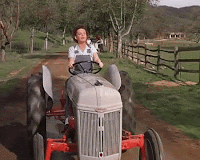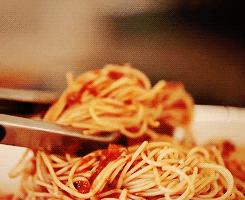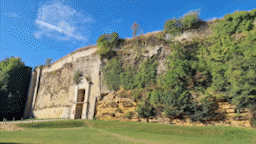A documentary film is a nonfictional motion picture intended to document some aspect of reality, primarily for the purposes of instruction or maintaining a historical record. Such films were originally shot on film stock—the only medium available—but now include video and digital productions that can be either direct-to-video, made into a TV show or released for screening in cinemas. "Documentary" has been described as a "filmmaking practice, a cinematic tradition, and mode of audience reception" that is continually evolving and is without clear boundaries
30 september 2015
Industriekultur/ Industrial Heritage
29 september 2015
Intro to Swedish silent movies
Swedish filmmaking rose to international prominence when Svenska Biografteatern moved from Kristianstad to Lidingö in 1911. During the next decade the company's two star-directors, Victor Sjöström and Mauritz Stiller, produced many outstanding silent films, some of the best of them adaptations of stories by the Nobel-prizewinning novelist Selma Lagerlöf. Sjöström's most respected films often made poetic use of the Swedish landscape and developed emotionally moving studies of character and emotion. Many of the films made at the Biografteatern had a significant impact on German directors of the silent and early sound eras, largely because Germany remained cut off from French, British, and American influences through World War I (1914–1918).
27 september 2015
Farmers markt. Bauernmarkt.
Just over a year ago, we became fascinated by the idea of discovering the world through someone else’s eyes. What if you could see through the eyes of a protester in Ukraine? Or watch the sunrise from a hot air balloon in Cappadocia? It may sound crazy, but we wanted to build the closest thing to teleportation. While there are many ways to discover events and places, we realized there is no better way to experience a place right now than through live video. A picture may be worth a thousand words, but live video can take you someplace and show you around.
19 september 2015
Touch of Italy
Stream quality
Stream quality refers to the quality of the image and audio transferred from the servers of the distributor to the user's home screen.
Higher-quality video such as video in high definition (720p+) requires higher bandwidth and faster connection speeds. The generally accepted kbit/s download rate needed to stream high-definition video that has been encoded with H.264 is 3500 kbit/s, whereas standard-definition television can range from 500 to 1500 kbit/s depending on the resolution on screen.
Napoli
A flashback is an interjected scene that takes the narrative back in time from the current point in the story. Flashbacks are often used to recount events that happened before the story's primary sequence of events to fill in crucial backstory. In the opposite direction, a flashforward (or prolepsis) reveals events that will occur in the future. Both flashback and flashforward are used to create suspense in a story, develop a character, or add structure to the narrative. In literature, internal analepsis is a flashback to an earlier point in the narrative; external analepsis is a flashback to a time before the narrative started.
In movies and television, several camera techniques and special effects have evolved to alert the viewer that the action shown is a flashback or flashforward; for example, the edges of the picture may be deliberately blurred, photography may be jarring or choppy, or unusual coloration or sepia tone, or monochrome when most of the story is in full color, may be used.
15 september 2015
Vacations in Italy
\In photography, reversal film is a type of photographic film that produces a positive image on a transparent base. The film is processed to produce transparencies or diapositives (abbreviated as "diafilm" in many countries) instead of negatives and prints. Reversal film is produced in various sizes, from 35 mm roll film to 8×10 inch sheet film.
A slide is a specially mounted individual transparency intended for projection onto a screen using a slide projector. This allows the photograph to be viewed by a large audience at once. The most common form is the 35 mm slide, with the image framed in a 2×2 inch cardboard or plastic mount. Some specialized labs produce photographic slides from digital camera images in formats such as JPEG, from computer-generated presentation graphics, and from a wide variety of physical source material such as fingerprints, microscopic sections, paper documents, astronomical images, etc.
Reversal film is sometimes used as motion picture film, mostly in the 16 mm, Super 8 and 8 mm "cine"
11 september 2015
Album des Ardennes
The advent of photography, from the Ancient Greek words , together meaning "drawing with light" or "representation by means of lines" or "drawing", has gained the interest of scientists and artists from its inception. Scientists have used photography to record and study movements, such as Eadweard Muybridge's study of human and animal locomotion (1887). Artists are equally interested in these aspects but also try to explore avenues other than the photo-mechanical representation of reality, such as the pictorialist movement.
Blues variations
Stock footage, and similarly, archive footage, library pictures and file footage is film or video footage that can be used in other films. Stock footage is beneficial to filmmakers as it saves shooting new material. A single piece of stock footage is called a "stock shot" or a "library shot" Stock footage may have appeared in previous productions but may also be outtakes or footage shot for previous productions and not used. Examples of stock footage which might be utilized are moving images of cities and landmarks, wildlife in their natural environments and historical footage. Suppliers of stock footage may be either rights-managed or royalty-free. Many websites offer direct downloads of clips in various formats.
08 september 2015
View on Amsterdam
What type of thing is film?
Film can be described as all of the following:
Art – aesthetic expression for presentation or performance, and the work produced from this activity
One of the visual arts – visual arts is a class of art forms, including painting, sculpture, photography, printmaking and others, that focus on the creation of works which are primarily visual in nature.
07 september 2015
Chateau Fort de Sedan
Filmmaking, can be a truly inspiring, rewarding and enjoyable ride, yet as any other craft it takes a lot of hard work, time and effort before you actually get to the tipping point of your career. Knowing the rules and learning how to use the right tools and techniques is only half of the equation. Staying disciplined and truly dedicated, knowing well all the ins and outs of the creative process, and making motivated and smart decisions on set is what actually will make you a successful artist in the end.
Cinematography as a vital part of filmmaking obeys almost the same rules. Undoubtedly, getting the best piece of equipment won’t necessarily make you a better storyteller. Yet, making consciousness and motivated decisions on the way you light your talents, frame your shots and move your camera eventually will.
04 september 2015
Capital des Marionnettes
A puppet is an inanimate object animated or manipulated by a puppeteer. It is used in puppetry, which is a very ancient form of theatre.
There are many different varieties of puppets, and they are made of a wide range of materials, depending on their form and intended use. They can be extremely complex or very simple in their construction.
Marionettes, or "string puppets," are suspended and controlled by a number of strings, plus sometimes a central rod attached to a control bar held from above by the puppeteer. The control bar can be either a horizontal or vertical one. Basic strings for operation are usually attached to the head, back, hands (to control the arms) and just above the knee (to control the legs). This form of puppetry is complex and sophisticated to operate, requiring greater manipulative control than a finger, glove or rod puppet. The puppet play performed by the Von Trapp children with Maria in The Sound of Music is a marionette show.
27 augustus 2015
Clay with the kids
Clay animation or claymation is one of many forms of stop motion animation. Each animated piece, either character or background, is "deformable"—made of a malleable substance, usually Plasticine clay.
Traditional animation, from cel animation to stop motion, is produced by recording each frame, or still picture, on film or digital media and then playing the recorded frames back in rapid succession before the viewer. These and other moving images, from zoetrope to films to videogames, create the illusion of motion by playing back at over ten to twelve frames per second. The techniques involved in creating CGI are conversely generally removed from a frame-by-frame process
Technique
Each object or character is sculpted from clay or other such similarly pliable material as Plasticine, usually around a wire skeleton called an armature, and then arranged on the set, where it is photographed once before being slightly moved by hand to prepare it for the next shot, and so on until the animator has achieved the desired amount of film. Upon playback, the human mind of the viewer perceives the series of slightly changing, rapidly succeeding images as motion.
A consistent shooting environment is needed to maintain the illusion of continuity: objects must be consistently placed and lit, and work must proceed in a calm environment.
24 augustus 2015
Les Ardennes Belgique
A good, sturdy tripod will let you get smooth pan or tilt movements, but for any other movements you could benefit from a home-made type of weight.
The simplest way to do this with a camera is to fold up or retract the legs of your tripod and keep the camera mounted on it. This gives you a good amount of weight beneath it and will prevent it from wobbling around to as great a degree as it would otherwise.
21 augustus 2015
Rocroi en Ardennes.
Battle of Rocroi, (May 19, 1643), a military engagement of the Thirty Years’ War in which a French army of 22,000 men, under the Duke d’Enghien (later known as the Great Condé), annihilated a Spanish army of 26,000 men under Don Francisco de Melo, marking the end of Spain’s military ascendancy in Europe.
The Spanish army crossed the French border from the Netherlands and then stopped to besiege the small fortress of Rocroi, 55 miles (88 km) northeast of Reims. Enghien advanced rapidly, knowing that the Spaniards were expecting reinforcements. On May 18 both armies positioned themselves with the bulk of their infantry in the centre, flanked by two wings of cavalry. Early on May 19 Enghien led a successful cavalry charge of the French right against the Spanish left.
17 augustus 2015
Petit tour (de France)
Semois Valley
Cinema of Belgium refers to the film industry based in Belgium. Belgium is essentially a bi-lingual country divided into the Flemish (Dutch-speaking) north and the French-speaking south. There is also a small community of German speakers in the border region with Germany. Belgium is further a federal country made up of three regions (the Flemish Region, the Walloon Region and the Brussels-Capital Region) and three language communities (the Flemish Community (Dutch-speaking), the French (i.e., French-speaking) Community and the German-speaking Community). Due to these linguistic and political divisions it is difficult to speak of a national, unified Cinema of Belgium. It would be more appropriate to talk about Flemish or Dutch-language cinema of Belgium and Walloon or French-language cinema of Belgium.
16 augustus 2015
Dreams of Bergman
Imaginary worlds, characters, items, etc. have been described in stories and tales since the dawn of humanity. In the philosophic discourse, utopias have existed where extensive systems and their components have been depicted in detail. Imaginary artifacts have been described and created in terms of language and visual presentation. The development of the visual presentation techniques (e.g. linear perspective, cinematography) enabled more sophisticated methods to describe these artifacts, events and entities in painting, photography and film. Moreover, virtual artifacts were (and still are) commonly found in environments that require a strong imaginary aspect in order to be experienced, such as radio shows, novels, tabletop role-playing games, etc.
Storytelling ( tropics museum)
The Tropenmuseum is a museum about people, housed in an impressive listed building overlooking Amsterdam’s Oosterpark.
The extensive permanent display and regularly changing exhibitions feature objects that all have a story to tell about humankind. Stories about universal human themes like mourning, celebration, ornamentation, prayer, conflict. From Africa to West and Southeast Asia, from New Guinea to Latin America: come to the Tropenmuseum and discover that, despite cultural differences, we are all essentially the same.
Tropenmuseum Junior is designed to appeal to visitors aged six to 13. It opened in 1975, making it the oldest children’s museum in the Netherlands. Entering Tropenmuseum Junior is like stepping into another world, an immersive experience that stimulates all the senses and allows children to learn by doing.
Garden of the Rijksmuseum
A hidden camera is a still or video camera used to film people without their knowledge. The camera is "hidden" because it is either not visible to the subject being filmed, or is disguised as another object. Hidden cameras have become popular for household surveillance, and can be built into common household objects such as smoke detectors, clock radios, motion detectors, ball caps, plants, and mobile phones. Hidden cameras may also be used commercially or industrially as security cameras.
Eleven cities skating tour
The tour, almost 200 km in length, follows a route along frozen canals, rivers and lakes visiting the eleven historic Frisian cities: Leeuwarden, Sneek, IJlst, Sloten, Stavoren, Hindeloopen, Workum, Bolsward, Harlingen, Franeker, Dokkum, then returning to Leeuwarden. The tour is held only if the ice is, and remains, at least 15 centimetres thick along the entire course as about 15,000 amateur skaters will take part, putting high requirements on the quality of the ice. The last tours were held in 1985, 1986 and 1997. All skaters must be members of the Association of the Eleven Frisian Cities. A starting permit is required. Skaters must collect a stamp in each city, and at three secret check points, and must finish the course before midnight.
The finishing point of the Elfstedentocht is a canal near Leeuwarden, called the "Bonkevaart", close to the landmark windmill, De Bullemolen, Lekkum.








.gif)










